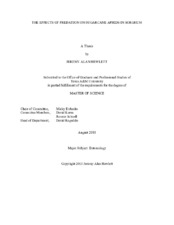| dc.description.abstract | The sugarcane aphid, Melanaphis sacchari Zehntner (Hemiptera: Aphididae), is an
emerging pest in sorghum, Sorghum bicolor (L.), in the USA. Lady beetles and green lacewings
are abundant in sugarcane aphid-infested sorghum fields, but little is known about the effects of
these predators on the establishment and growth of sugarcane aphid populations in sorghum. I
quantified the effect of two species of lady beetles (Coccinella septempunctata L. and Harmonia
axyridis Pallas) (Coleoptera: Coccinellidae) and green lacewings (Chrysoperla rufilabris
Burmeister) (Neuroptera: Chrysopidae) on aphid colony growth across several aphid densities. I
incorporated these predator effects into a dynamic predator-prey model to predict the impact of
predators on the short-term population dynamics of sugarcane aphids and their ability to suppress
aphids below action thresholds in sorghum. I also compared the effects of aphid-resistant
sorghum on predation by lacewing larvae.
All predators were able to significantly reduce the growth of sugarcane aphid populations
at low to intermediate aphid densities (20, 40, and 80 aphids per colony). At the highest aphid
density (160 aphids), H. axyridis larvae were much less effective and lacewing larvae did not
suppress sugarcane aphid colony growth. The model found that all predators prevented aphid
densities between 20-40 per leaf from reaching action thresholds and at densities of 80 aphids
per colony, all predators suppressed aphids below threshold in two to four days. However, at the
highest initial aphid density (160), H. axyridis larvae required seven days to suppress aphids
below threshold and lacewing larvae never suppressed aphids below threshold.
Aphid-resistant cultivars sustained smaller populations of aphids compared to
susceptible. However, predators were an overall more effective tool to reduce aphid densities
than use of only resistant varieties. As there is some evidence that predators may be more
attracted to aphid-infested resistant varieties, predator effects may be enhanced on these
varieties. My results suggest that common predators have the potential to reduce the number of
insecticide applications needed to control sugarcane aphids and should be incorporated into
Integrated Pest Management (IPM) programs. The simultaneous use of biological control and
resistant varieties may yield synergistic suppression of sugarcane aphids in sorghum. | en |


